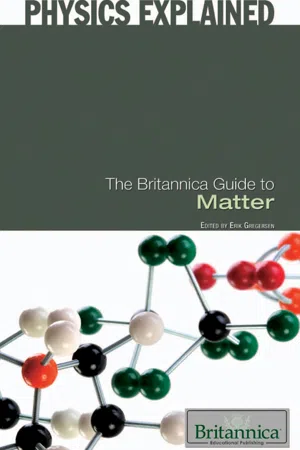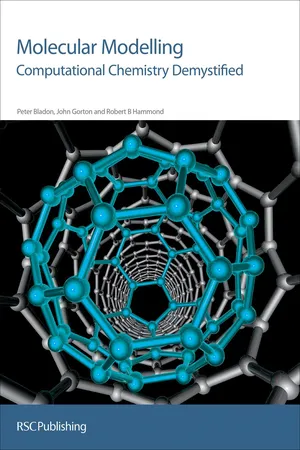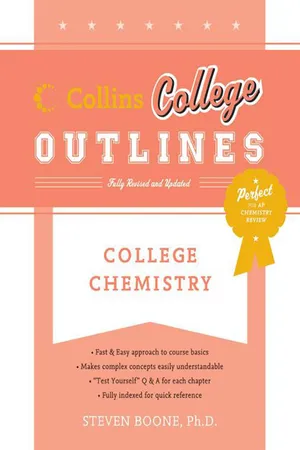Chemistry
Molecular Solid
A molecular solid is a type of solid material in which the constituent particles are individual molecules held together by intermolecular forces. These solids have relatively low melting points and are typically soft and easily deformable. Examples of molecular solids include ice, sugar, and organic compounds such as paraffin wax.
Written by Perlego with AI-assistance
Related key terms
Related key terms
1 of 4
Related key terms
1 of 3
6 Key excerpts on "Molecular Solid"
- eBook - ePub
- Britannica Educational Publishing, Erik Gregersen(Authors)
- 2010(Publication Date)
- Britannica Educational Publishing(Publisher)
Some molecules may exist in the liquid crystal state, which is intermediate to the crystalline solid and liquid states. Liquid crystals flow like liquids yet display a certain degree of the symmetry characteristic of crystalline solids.Four principal types of atomic bonds are found in crystalline solids: metallic, ionic, covalent, and molecular. Metals and their alloys are characterized in the main by their high electrical and thermal conductivity, which arise from the migration of free electrons; free electrons also influence how the atoms bond. Ionic crystals are aggregates of charged ions. These salts commonly exhibit ionic conductivity, which increases with temperature. Covalent crystals are hard, frequently brittle materials such as diamond, silicon, and silicon carbide. In the simpler, monatomic types (e.g., diamond), each atom is surrounded by a number of atoms equal to its valence. Molecular crystals are substances that have relatively weak intermolecular binding, such as dry ice (solidified carbon dioxide), solid forms of the rare gases (e.g., argon, krypton, and xenon), and crystals of numerous organic compounds.Various alloys, salts, covalent crystals, and molecular crystals that are good electrical insulators at low temperature become conductors at elevated temperatures, conductivity increasing rapidly with temperature. Materials of this type are called semiconductors. Their electrical conductivity is generally low when compared with that of such metals as copper, silver, or aluminum.BASIC UNITS OF SOLIDS
The definition of a solid appears obvious; a solid is generally thought of as being hard and firm. Upon inspection, however, the definition becomes less straightforward. A cube of butter, for example, is hard after being stored in a refrigerator and is clearly a solid. After remaining on the kitchen counter for a day, the same cube becomes quite soft, and it is unclear if the butter should still be considered a solid. Many crystals behave like butter in that they are hard at low temperatures but soft at higher temperatures. They are called solids at all temperatures below their melting point. A possible definition of a solid is an object that retains its shape if left undisturbed. The pertinent issue is how long the object keeps its shape. A highly viscous fluid retains its shape for an hour but not a year. A solid must keep its shape longer than that. - eBook - ePub
- Jeffrey Gaffney, Nancy Marley(Authors)
- 2017(Publication Date)
- Elsevier(Publisher)
Most Molecular Solids are soft, but can also be ductile or brittle. While brittle solids fracture immediately when enough stress is applied, ductile solids undergo a period of deformation followed by fracture. The intermolecular forces in many Molecular Solids are directional, leading to mechanical properties that vary with the direction of the applied stress. Molecular Solids are usually insulators because the localization of electrons in the covalent bonds of the molecules prevents their movement in the crystal lattice. However, if an alkali metal is intercolated into the crystal lattice voids, the valence electrons on the alkali metal can be easily ionized allowing them to move freely in the crystal lattice. This gives the Molecular Solid electrical conductivity it would not otherwise have without significantly changing the other properties.11.4 Atomic Solids
Atomic solids , also called network solids, are composed of atoms connected by covalent bonds in a continuous network. There are two types of atomic solids: those that are totally composed of an extended three-dimensional covalent network and those that are composed of two-dimensional covalent networks, which are held together by weaker van der Waals forces (mixed bonding). In the three-dimensional networks, the covalent bonding extends throughout the solid and the result is a macroscopic interlocking covalent lattice structure. Any distortion of the crystal geometry can only occur through breaking the strong covalent bonds. In the two-dimensional networks, distortion of the three-dimensional geometry is more easily accomplished by disturbing the weaker intermolecular forces holding the two-dimensional planes together.The most common examples of atomic solids are the allotropes of carbon. These allotropes, different solid forms of carbon, are shown in Fig. 11.9 - eBook - ePub
- Milton Ohring(Author)
- 2001(Publication Date)
- Academic Press(Publisher)
Chapter 1 A Review of Materials Science1.1 INTRODUCTION
A cursory examination of the vast body of solid substances reveals what outwardly appears to be an endless multitude of external forms and structures possessing a bewildering variety of properties. The branch of study known as Materials Science evolved in part to classify those features that are common among the structure and properties of different materials in a manner somewhat reminiscent of chemical or biological classification schemes. This dramatically reduces the apparent variety. From this perspective, it turns out that solids can be classified as belonging typically to one of only four different categories (metallic, ionic, covalent, van der Waals) depending on the nature of the electronic structure and resulting interatomic bonding forces. Another scheme based on engineering use would again arguably limit materials to four chief classes, namely, metals, semiconductors, polymers, and ceramics.Similar divisions occur with respect to structure of solids. Solids are either internally crystalline or noncrystalline. Those that are crystalline can be further subdivided according to one of 14 different geometric arrays or lattices depending on the placement of the atoms. When properties are considered, there are similar descriptors and simplifying categorizations. Thus, materials are either good, intermediate, or poor conductors of electricity, they are either mechanically brittle or can easily be stretched without fracture, they are either optically reflective or transparent, etc. It is, of course, easier to recognize that property differences exist than to understand why they exist. Nevertheless, much progress has been made in this subject as a result of the research of the past century. Basically, the richness in the diversity of materials properties occurs because countless combinations of the admixture of chemical compositions, bonding types, crystal structures, and morphologies either occur naturally or can be synthesized. - eBook - ePub
Molecular Modelling
Computational Chemistry Demystified
- Peter Bladon, John Gorton, Robert B Hammond(Authors)
- 2019(Publication Date)
- Royal Society of Chemistry(Publisher)
Chapter 7 Molecular Modelling and the Solid State of Materials7.1 IntroductionHere we address the application of molecular modelling techniques to the solid state of matter. To tackle the subject exhaustively is a massive undertaking and beyond the scope of this modest chapter. However, a number of topics will be discussed that are, from a historical perspective, seminal to the subject. Initially let us consider the sorts of questions about solids one may like to address through molecular modelling. High value-added chemical products, often referred to as speciality materials, are predominantly produced as solids1 . Hence, one perspective to consider is that of process engineers. Tasked with synthesising and formulating solids, they want to know how such materials will behave under processing conditions and how to safely and efficiently scale-up processes to produce the desired quantities of a given product. Another perspective is that of the physicist, chemical physicist or materials scientist who wants to understand the relationship between the underlying, atomic-scale structure of solids and their properties and characteristics as functional materials, e.g. as electronic devices, sensors, pharmaceuticals, foodstuffs, and pigments to name just a few types.Molecular modelling is being employed to address perhaps the most fundamental question about solids: how to predict the atomic-scale structure of crystalline solids from first principles. Over twenty years ago, John Maddox2 described our lack of ability to predict, routinely, the internal structure or packing arrangement of Molecular Solids solely from knowledge of the molecular structure as “one of the continuing scandals in the physical sciences”. Academic and commercial entities now have access to levels of computing power far greater than Maddox could have envisaged when he made his statement. Nevertheless, although a lot more is now understood about the reasons for the difficulty and many of the obstacles have been overcome,3 , 4 - No longer available |Learn more
- Steven Boone, Drew H. Wolfe(Authors)
- 2011(Publication Date)
- Collins Reference(Publisher)
2 , and silicon carbide, SiC. Because of their strong covalent bonds and network of interconnected atoms, macroMolecular Solids are unusually hard substances with extremely high melting points. The electrons in network covalent solids are held tightly in the bonds and cannot be displaced, so network covalent solids do not conduct an electric current. Most macroMolecular Solids are also poor conductors of heat, except diamond, which is an excellent thermal conductor. Nonmetals conduct heat solely by atomic vibration, which is a less efficient mechanism than moving electrons, which is how metals conduct heat. In diamond, the vibrational energy travels through the crystal along the strong internal chemical bonds.Molecular SolidsMolecular Solids have molecules in their crystal lattice points. These molecules are bound by the same intermolecular forces found in liquids: London dispersion forces; dipole-dipole interactions; and hydrogen bonds. Examples of Molecular Solids include HC1(s), H2 O(s), and I2 O(s) These three solids have HCl, H2 O, and I2 molecules in their respective lattice points. The intermolecular forces for HC1, H2 O(s), and I2 (s) are dipole-dipole interactions, hydrogen bonds, and London forces, respectively. Besides the intermolecular forces, the properties of Molecular Solids depend on how well the molecules fit into the lattice points. Because intermolecular forces are weak compared to ionic and covalent bonds, Molecular Solids tend to be soft and have low to moderate melting points. Some Molecular Solids sublime under normal atmosphere pressure. With the electrons tightly held in the covalent bonds within the molecules, Molecular Solids are poor conductors of heat and electricity.Metallic SolidsMetallic solids differ significantly from the other classes of solids. They have positive nuclei at the crystal lattice points surrounded by delocalized electrons. Metal nuclei attract their own electrons as well as electrons from 8 to 12 adjacent atoms. An old chemistry cliché states that the structure of metals is “metal nuclei in a sea of electrons.” Thus, the intermolecular forces in metals are the electrostatic attraction of nuclei for the delocalized electrons. This type of bond is called a metallic bond . As a result of having delocalized electrons and metallic bonds, metals are good conductors of heat and electricity and have a wide range of melting points. The electrical conductivity of metals is from 10 to l05 - eBook - ePub
- Richard A. Storey, Ingvar Ymén(Authors)
- 2011(Publication Date)
- Wiley-Blackwell(Publisher)
Chapter 1 Introduction to the Solid State – Physical Properties and Processes Ingvar Ymén AstraZeneca R&D, Södertälje, Sweden 1.1 IntroductionPharmaceutical substances consist of organic molecules alone, or in combination with metal cations (metal salts), organic cations, organic or inorganic anions, neutral organic molecules (co-crystals) or solvent molecules (solvates). Even though some are salts, these have little resemblance with inorganic salts, the typical properties of which include high melting points, high hardness and strong ionic bonding. In fact, pharmaceutical substances, as salts or not, generally have similar properties, which are dominated by the presence of the organic molecules and their typical, weak intermolecular interactions. Crystals formed by organic substances are usually referred to as molecular crystals (Kitaigorodsky 1973) and it is the properties of this type of molecules that will be referred to when talking about the properties of pharmaceutical substances. In the following the physical states of a pure pharmaceutical substance will be discussed with reference to Figure 1.1 where the approximate areas of existence as a function of temperature are shown.1.1.1 The Gas/Vapour and Liquid StatesFigure 1.1 Different possible physical states of a pharmaceutical substance as a function of temperature; it is assumed that the pressure is constant at 1 atmosphereA gas consists of molecules, moving independently of each other, but occasionally colliding with each other or with the vessel in which it is contained. The collisions make up the gas pressure and the more collisions the higher is the pressure. A gas containing small, point-like molecules with negligible molecular interactions is called ideal. For such a gas:where p = pressure, V = volume, n = the number of moles, T = temperature and R = the gas constant. Most gases are nonideal because their molecules are not pointlike and they interact to some extent. Gases at high temperatures are closest to ideal and the deviation from ideality increases closer to the point of condensation. In a mixture of ideal gases each gas will exert a pressure, which is proportional to the amount of that gas. The total pressure is the sum of the individual pressures so that for n different ideal gas molecules:
Index pages curate the most relevant extracts from our library of academic textbooks. They’ve been created using an in-house natural language model (NLM), each adding context and meaning to key research topics.
Explore more topic indexes
Explore more topic indexes
1 of 6
Explore more topic indexes
1 of 4





